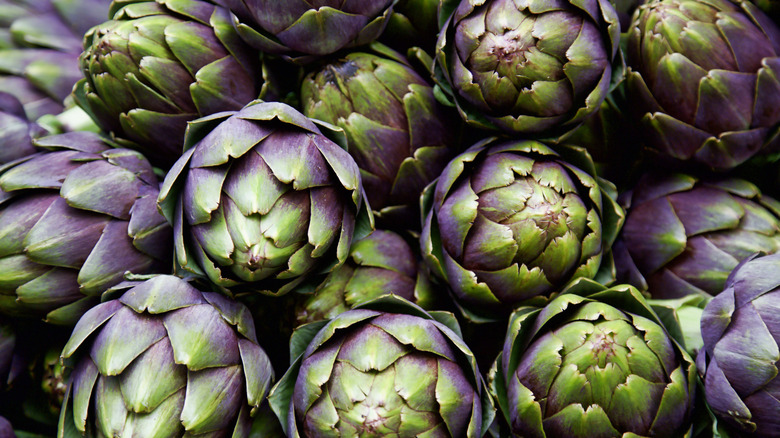The Difference Between Green And Jerusalem Artichokes
The food world is filled with misnomers — things whose names don't necessarily align with their composition. (We can't be the only ones who grew up thinking Welsh rabbit contained actual rabbit meat, only to learn well into adulthood that it's a vegetarian dish made of cheese and bread.) To that end, Jerusalem artichokes, also known as sunroot or sunchokes, have a misleading name. Not only do they lack ties to Jerusalem, but unlike the vegetable you think of when you hear the word "artichoke," with its pinecone shape and rosette of pointed leaves, Jerusalem artichokes resemble stocky turnips or ginger root. In fact, the two vegetables are only loosely related.
While both plants belong to the Asteraceae family, their appearance and origins are vastly different. Green artichokes are the buds of thistle plants, harvested in the spring before they sprout large purple flowers, while Jerusalem artichokes are knobby root vegetables more closely related to sunflowers, pulled from the ground in the winter months. Their main commonality? They're both delicious.
From girasole to Jerusalem
Although Jerusalem artichokes are not from Israel, their moniker is not entirely random. The tuber, which originates in the Central United States and Canada, takes its name from the Italian word for sunflower, girasole, which, if heard over the din of a busy day at the farmers market or pronounced by someone who doesn't speak Italian, sort of sounds like "Jerusalem."
Indigenous Americans have long referred to the vegetable as sunroot, but when the French explorer Samuel de Champlain learned about them on his travels during the early 16th century, he thought they tasted a bit like artichokes. Thus, their slightly clunky new name was born. He showed them to his friends back in France, where they're now also called topinambours.
Green artichokes, on the other hand, are native to the Mediterranean and North Africa and were potentially first eaten at the start of the 15th century (if not before) in Italy. However, some academics believe the plants were harvested as early as the 9th century.
A versatile side
Jerusalem artichokes might not be as well-known as their spiky, blossoming counterparts, but some might find them a bit easier to work with — if not more versatile — in the kitchen. While green artichokes are typically steamed and eaten leaf by leaf down to their tender heart or stuffed, Sicilian style with a mixture of parmesan and breadcrumbs, Jerusalem artichokes can be treated similarly to potatoes.
One of the easiest and tastiest places to start is to peel them, slice them into discs or chunks, and roast them in the oven with olive oil, salt, and herbs until they're crispy on the outside and creamy on the inside. They make for a perfectly starchy side that's plenty nutritious and a great alternative to a dish of roasted potatoes. Likewise, they can be mashed, fried, and pureed into a silky soup or dip.
We're not picking sides here (Who doesn't love dipping piles of green artichoke leaves in melted butter or classic homemade aioli?), but if you've never had Jerusalem artichokes, you're missing out. Just don't expect them to be much at all like their namesake.


